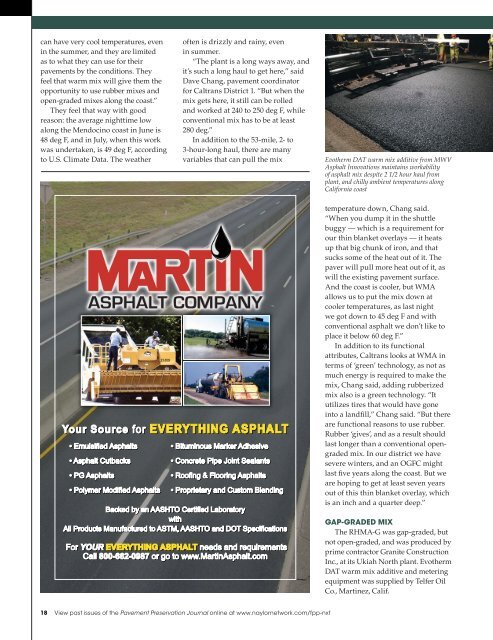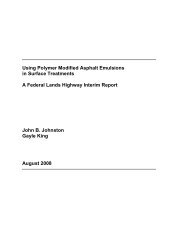journal - TSP2
journal - TSP2
journal - TSP2
You also want an ePaper? Increase the reach of your titles
YUMPU automatically turns print PDFs into web optimized ePapers that Google loves.
can have very cool temperatures, even<br />
in the summer, and they are limited<br />
as to what they can use for their<br />
pavements by the conditions. They<br />
feel that warm mix will give them the<br />
opportunity to use rubber mixes and<br />
open-graded mixes along the coast.”<br />
They feel that way with good<br />
reason: the average nighttime low<br />
along the Mendocino coast in June is<br />
48 deg F, and in July, when this work<br />
was undertaken, is 49 deg F, according<br />
to U.S. Climate Data. The weather<br />
often is drizzly and rainy, even<br />
in summer.<br />
“The plant is a long ways away, and<br />
it’s such a long haul to get here,” said<br />
Dave Chang, pavement coordinator<br />
for Caltrans District 1. “But when the<br />
mix gets here, it still can be rolled<br />
and worked at 240 to 250 deg F, while<br />
conventional mix has to be at least<br />
280 deg.”<br />
In addition to the 53-mile, 2- to<br />
3-hour-long haul, there are many<br />
variables that can pull the mix<br />
Evotherm DAT warm mix additive from MWV<br />
Asphalt Innovations maintains workability<br />
of asphalt mix despite 2 1/2 hour haul from<br />
plant, and chilly ambient temperatures along<br />
California coast<br />
temperature down, Chang said.<br />
“When you dump it in the shuttle<br />
buggy — which is a requirement for<br />
our thin blanket overlays — it heats<br />
up that big chunk of iron, and that<br />
sucks some of the heat out of it. The<br />
paver will pull more heat out of it, as<br />
will the existing pavement surface.<br />
And the coast is cooler, but WMA<br />
allows us to put the mix down at<br />
cooler temperatures, as last night<br />
we got down to 45 deg F and with<br />
conventional asphalt we don’t like to<br />
place it below 60 deg F.”<br />
In addition to its functional<br />
attributes, Caltrans looks at WMA in<br />
terms of ‘green’ technology, as not as<br />
much energy is required to make the<br />
mix, Chang said, adding rubberized<br />
mix also is a green technology. “It<br />
utilizes tires that would have gone<br />
into a landfill,” Chang said. “But there<br />
are functional reasons to use rubber.<br />
Rubber ‘gives’, and as a result should<br />
last longer than a conventional opengraded<br />
mix. In our district we have<br />
severe winters, and an OGFC might<br />
last five years along the coast. But we<br />
are hoping to get at least seven years<br />
out of this thin blanket overlay, which<br />
is an inch and a quarter deep.”<br />
GAP-GRADED MIX<br />
The RHMA-G was gap-graded, but<br />
not open-graded, and was produced by<br />
prime contractor Granite Construction<br />
Inc., at its Ukiah North plant. Evotherm<br />
DAT warm mix additive and metering<br />
equipment was supplied by Telfer Oil<br />
Co., Martinez, Calif.<br />
424523_Martin.indd 18 View past 1 issues of the Pavement Preservation Journal online at www.naylornetwork.com/fpp-nxt<br />
4/8/09 8:46:10 PM
















